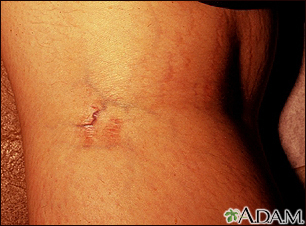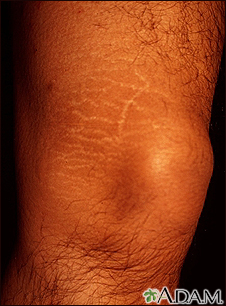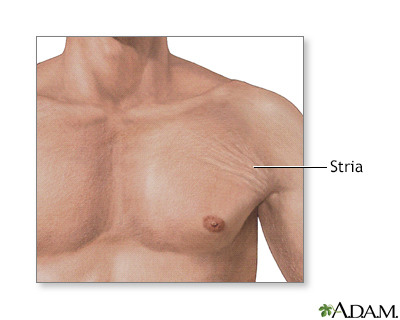Finding the Root of the Problem
Ask Ethan Church what he’s passionate about and the answer may seem unusual for a 17-year-old: forestry and soil science. A first-degree black belt assistant…

Update your location to show providers, locations, and services closest to you.
Stretch marks are irregular areas of skin that look like bands, stripes, or lines. Stretch marks are seen when a person grows or gains weight rapidly or has certain diseases or conditions.
The medical name for stretch marks is striae.
Striae; Striae atrophica; Striae distensae
Stretch marks can appear when there is rapid stretching of the skin. The marks appear as parallel streaks of red, thinned, glossy skin that over time become whitish and scar-like in appearance. Stretch marks may be slightly depressed and have a different texture than normal skin.
They are often seen when a woman's abdomen gets larger during pregnancy. They can be found in children who have become rapidly obese. They may also occur during the rapid growth of puberty. Stretch marks are most commonly located on the breasts, hips, thighs, buttocks, abdomen, and flank.
Causes of stretch marks may include any of the following:
There is no specific care for stretch marks. Marks often disappear after the cause of the skin stretching is gone.
Avoiding rapid weight gain helps reduce stretch marks caused by obesity.
If stretch marks appear without a clear cause, such as pregnancy or rapid weight gain, call your health care provider.
Your provider will examine you and ask about your symptoms, including:
If the stretch marks are not caused by normal physical changes, tests may be done. Tretinoin cream may help reduce stretch marks. Laser treatment may also help. In very rare cases, surgery may be done.



James WD, Elston DM, Treat JR, Rosenbach MA, Neuhaus IM. Abnormalities of dermal fibrous and elastic tissue. In: James WD, Elston DM, Treat JR, Rosenbach MA, Neuhaus IM, eds. Andrews' Diseases of the Skin. 13th ed. Philadelphia, PA: Elsevier; 2020:chap 25.
Patterson JW. Disorders of collagen. In: Patterson JW, ed. Weedon's Skin Pathology. 5th ed. Philadelphia, PA: Elsevier Limited; 2021:chap 12.
Ask Ethan Church what he’s passionate about and the answer may seem unusual for a 17-year-old: forestry and soil science. A first-degree black belt assistant…

Pregnancy and breastfeeding change the body, and while the result of having a new child is more than gratifying, some new mothers may find themselves…
